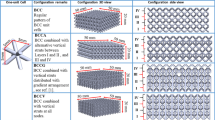Abstract
The problem of simulated low-velocity hail impacts on flexible photovoltaic (PV) modules resting on a substrate with variable stiffness is investigated. For this type of PV module it is shown that the prescriptions of the IEC 61215 International Standard for quality control used for rigid (glass-covered) PV modules should be augmented by taking into account their real mounting condition and the stiffness of the substrate in the simulated hail impact tests. Moreover, electroluminescence inspection of the crack pattern should be made in addition to electric power output measurements. An implicit finite element simulation of the contact problem in dynamics is also proposed, with two different degrees of accuracy, to interpret the experimentally observed extension of cracking. Results pinpoint the important role of stress wave propagation and reflection in the case of soft substrates.













Similar content being viewed by others
References
Meyer EL, van Dyk EE (2004) Assessing the reliability and degradation of photovoltaic module performance parameters. IEEE Trans Reliab 53:83–92
Paggi M, Kajari-Schröder S, Eitner U (2011) Thermomechanical deformations in photovoltaic laminates. J Strain Anal Eng Des 46:772–782
Paggi M, Berardone I, Infuso A, Corrado M (2014) Fatigue degradation and electric recovery in silicon solar cells embedded in photovoltaic modules. Sci Rep 4:4506
Paggi M, Corrado M, Rodriguez MA (2013) A multi-physics and multi-scale numerical approach to microcracking and power-loss in photovoltaic modules. Compos Struct 95:630–638
Paggi M, Berardone I, Corrado M (2016) A global/local approach for the prediction of the electric response of cracked solar cells in photovoltaic modules under the action of mechanical loads. Eng Fract Mech. doi:10.1016/j.engfracmech.2016.01.018
Lenarda P, Paggi M (2016) A geometrical multi-scale numerical method for coupled hygro-thermo-mechanical problems in photovoltaic laminates. Comput Mech 57:947–963
Moore D, Wilson A, Ross R (1978) Simulated hail impact testing of photovoltaic solar panels. In: Proceedings of 24th annual technical meeting, Institute of Environmental Sciences, Ft. Worth, TX, 18–20 April 1978, pp 419–430
Sapora A, Paggi M (2014) A coupled cohesive zone model for transient analysis of thermoelastic interface debonding. Comput Mech 53:845–857
Berardone I, Corrado M, Paggi M (2014) A generalized electric model for mono and polycrystalline silicon in the presence of cracks and random defects. Energy Procedia 55:22–29
International Standards IEC 61215:2006 (2006) Crystalline silicon terrestrial photovoltaic (PV) modules—design qualification and type approval
Wriggers P, Van Vu T, Stein E (1990) Finite element formulation of large deformation impact–contact problems with friction. Comput Struct 37:319–331
Laursen TA (2002) Computational contact and impact mechanics. Springer, Berlin
Wriggers P (2006) Computational contact mechanics. Springer, Berlin
Yu C, Ortiz M, Rosakis AJ (2003) 3D modelling of impact failure in sandwich structures. Eur Struct Integr Soc 32:527–537
Zavarise G, Bacchetto A (2006) Nail shooting on a steel support. In: Prez-Aparicio JL (ed) Practical applications using computational contact mechanics. The TCN series on simulation based engineering and sciences, vol 2. Consorzio TCN, Trento, pp 143–196
Richardson MOW, Wisheart MJ (1996) Review of low-velocity impact properties of composite materials. Compos A 27A:1123–1131
Xu LR, Rosakis AJ (2002) Impact failure characteristics in sandwich structures. Part I: basic failure mode selection. Int J Solids Struct 39:4215–4235
Xu LR, Rosakis AJ (2002) Impact failure characteristics in sandwich structures. Part II: effects of impact speed and interfacial strength. Int J Solids Struct 39:4237–4248
Hazizan MA, Cantwell WJ (2002) The low velocity impact response of foam-based sandwich structures. Compos B 33:193–204
Ivañez I, Sanchez-Saez S (2013) Numerical modelling of the low-velocity impact response of composite sandwich beams with honeycomb core. Compos Struct 106:716–723
Kim H, Kedward KT (2000) Modeling hail ice impacts and predicting impact damage initiation in composite structures. AIAA J 38:1278–1288
Kim H, Welch DA, Kedward KT (2003) Experimental investigation of high velocity ice impacts on woven carbon/epoxy composite panels. Compos A 34:25–41
Anghileri M, Castelletti LML, Invernizzi F, Mascheroni M (2005) A survey of numerical models for hail impact analysis using explicit finite element codes. Int J Impact Eng 31:929–944
Olsson R, Juntikka R, Asp LE (2013) High velocity hail impact on composite laminates—modelling and testing. In: Abrate S, Castani B, Rajapakse YDS (eds) Dynamic failure of composite and sandwich structures. Springer, Berlin, pp 393–426
Nelva R, Morra L (2009) L’effetto della grandine su cupole e lucernari. Zenital, Monza
Johnson KL (1985) Contact mechanics. Cambridge University Press, Cambridge
Zienkiewicz OC, Taylor RL (2000) The finite element method, 5th edn. Butterworth-Heinemann, Oxford
Paggi M, Sapora A (2015) An accurate thermoviscoelastic rheological model for Ethylene Vinyl Acetate based on fractional calculus. Int J Photoenergy 2015:252740
Ojo SO, Paggi M (2016) A thermo-visco-elastic shear-lag model for the prediction of residual stresses in photovoltaic modules after lamination. Compos Struct 136:481–492
Abrate S (2001) Modeling of impacts on composite structures. Compos Struct 51:129–138
Acknowledgments
This research has received funding from the European Research Council under the European Union’s Seventh Framework Programme (FP/2007–2013)/ERC Grant Agreement No. 306622 (ERC Starting Grant “Multi-field and multi-scale Computational Approach to Design and Durability of PhotoVoltaic Modules”—CA2PVM).
Author information
Authors and Affiliations
Corresponding author
Rights and permissions
About this article
Cite this article
Corrado, M., Infuso, A. & Paggi, M. Simulated hail impacts on flexible photovoltaic laminates: testing and modelling. Meccanica 52, 1425–1439 (2017). https://doi.org/10.1007/s11012-016-0483-2
Received:
Accepted:
Published:
Issue Date:
DOI: https://doi.org/10.1007/s11012-016-0483-2




